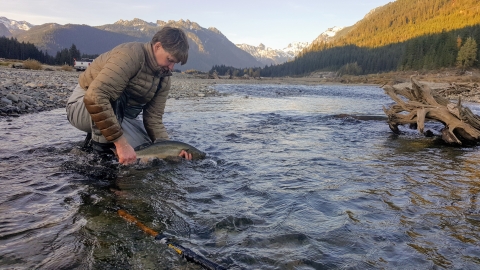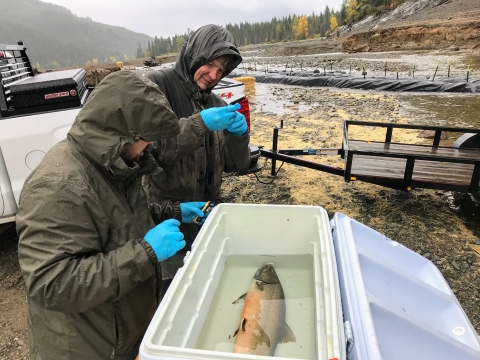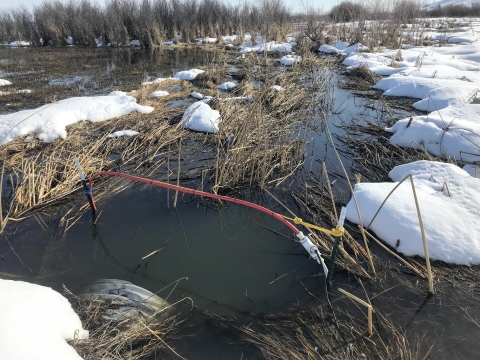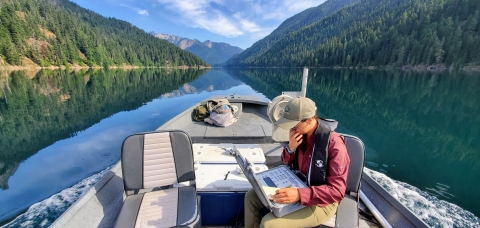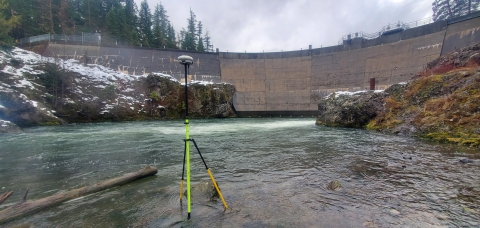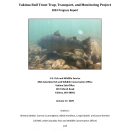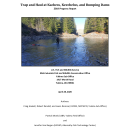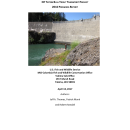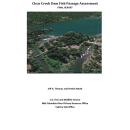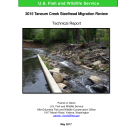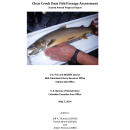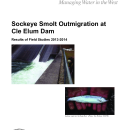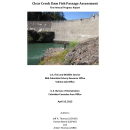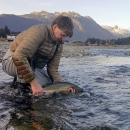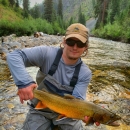States
WashingtonThe goal of the Yakima Program is the recovery of native anadromous and resident fish populations. The program focuses on four primary objectives: improving instream flows, restoring degraded aquatic habitat, protecting existing high quality habitat, and providing access to headwater habitats.
What We Do
To address the complexity of resource issues and tribal trust responsibilities in the Yakima Basin, Mid-Columbia Fish & Wildlife Conservation Office (MCFWCO) operates a sub-office of three biologists in Yakima, Washington.
Building and maintaining relationships with numerous natural resource partners and local stakeholders continues to be essential to the success of the Yakima Program. Through participation in numerous committees and technical workgroups, Yakima staff seek to advance the Service’s goals of ecological restoration and landscape-scale solutions to complex environmental problems.
The collection of relevant, objective biological data is an extremely important component of our work in the Yakima Basin. Scientific diligence in the collection and analyses of these data ensures that our recommendations are scientifically sound and management decisions are fully informed.
Bull Trout Recovery and Monitoring Efforts
As an interim passage measure, we conduct bull trout trap and haul below Bureau of Reclamation Dams and monitoring of transported fish. This program moves bull trout upstream of dams, allowing bull trout to access their natal spawning tributaries. Transported fish are monitored using both PIT (Passive Integrated Transponder) tags and acoustic telemetry. We estimate annual survival of adult bull trout that have been transported and assess run timing and movement patterns. These data inform reservoir operations and conservation actions.
We continue to assist the Central Washington Ecological Services Office with consultations in the Yakima Basin. We work with the Washington State Department of Fish and Wildlife, Yakama Nation, Mid-Columbia Fisheries Enhancement Group, and others to monitor bull trout populations.
Monitoring includes, but is not limited to: conducting redd surveys to determine spawner relative abundance, eDNA surveys to determine presence/absence, acoustic telemetry, mark-recapture surveys, and snorkel surveys.
Fisheries and aquatic studies
Yakima River Basin Water Enhancement Project (YRBWEP): Many tributary streams in the Yakima Basin were disconnected from the Yakima River and made inaccessible to migratory fishes (including salmon and steelhead) over the past century. Congress passed the YRBWEP legislation in 1994 to help improve fish and wildlife habitat, including provisions to enhance Yakima Basin tributary streams affected by irrigation development. A high priority tributary for restoration was Taneum Creek, a tributary to the Yakima River in Kittitas County, Washington. Many organizations and individuals including the U.S. Fish and Wildlife Service contributed to Taneum Creek habitat restoration. Fish screens and ladders were built, passage barriers were removed, and habitat was improved. Following these actions, monitoring of fish runs concluded that steelhead trout naturally recolonized Taneum Creek, and that newly constructed fish passage fish passage
Fish passage is the ability of fish or other aquatic species to move freely throughout their life to find food, reproduce, and complete their natural migration cycles. Millions of barriers to fish passage across the country are fragmenting habitat and leading to species declines. The U.S. Fish and Wildlife Service's National Fish Passage Program is working to reconnect watersheds to benefit both wildlife and people.
Learn more about fish passage structures allow fish to migrate freely up and down the creek. Some tributaries remain disconnected from the Yakima River, presenting opportunities to further salmon and steelhead recovery. Monitoring continues to evaluate fishery restoration activities for long-term viability and contribution to recovery of ESA-listed species.
Toppenish Creek steelhead smolt routing and survival: We evaluate routing and survival of marked steelhead smolts as they migrate downstream through Toppenish Creek each spring. Data from PIT- antenna arrays are used to develop detection histories and, ultimately, multi-state mark-recapture models. The models estimate detection probabilities and reach specific survival estimates. Detection information is also used to inform water management at Toppenish National Wildlife Refuge.
Yakima Basin Acoustic Telemetry: We use acoustic telemetry to inform conservation actions within the Yakima Basin by examining spatio-temporal use of lentic systems. We are currently examining the use of Kachess and Keechelus lakes by hatchery reared bull trout under a program conducted by the Yakama Nation. Data will be used to evaluate the rearing program and inform conservation actions.
Clear Creek Dam Fish Passage: The Clear Creek Dam Fish Passage Assessment is a cooperative investigation conducted by staff from the U.S. Fish and Wildlife Service's Mid-Columbia Fish & Wildlife Conservation Office (Yakima Sub-Office), the U.S. Bureau of Reclamation's Columbia-Cascades Area Office, and the Washington Department of Fish and Wildlife (Region 3).
The local population of bull trout which spawns in the North Fork Tieton River was officially recognized in 2004 when biologists led by the Yakima Sub-Office observed juvenile bull trout and documented spawning activity for the first time during a comprehensive fish census conducted in the North Fork Tieton River above Clear Creek Dam (USFWS 2005). The dam was constructed on the North Fork Tieton in 1914 without fish ladders. While the spillway channel was retrofitted with ladders in 1992, these ladders are ineffective and that bull trout are, for the most part, unable to migrate past the dam to reach headwater spawning habitat. This study has resulted in the planning and design of a new fish ladder at the site. The ladder will help to ensure the long-term health and persistence of this population of bull trout.
Yakima Basin Water Temperature Monitoring: We maintain a network of water temperature loggers throughout the basin. Loggers are left in place all year and downloaded on a monthly basis, with the exception of sites that become inaccessible during winter.
Groups We Work With
Systems Operation Advisory Committee (SOAC): This group advises the Reclamation Yakima Project Manager on operations of their water storage and distribution system. They also develop strategies to protect the spawning needs of Pacific salmon while minimizing the dependence on extra releases of water. SOAC also provides expertise and advise on instream flows during spring and early summer months to improve survival of outmigrating smolts. (USFWS representative: Craig Haskell)
Yakima Basin Integrated Plan Workgroup: This group provides policy and project development advice on implementing the Yakima River Basin integrated water resource plan. In June 2009, representatives from the Yakama Nation, irrigation districts, environmental organizations, and federal, state, county, and city governments came together to help develop a consensus-based solution to the basin’s water problems. Over the next 18 months, the group developed the Yakima River Basin Integrated Water Resource Management Plan. This comprehensive plan combines new (or enhanced) water storage facilities and water conservation measures with fish recovery measures. Its purpose is to provide a secure water supply for drought and future need (agriculture and municipal) in the face of expected climate change climate change
Climate change includes both global warming driven by human-induced emissions of greenhouse gases and the resulting large-scale shifts in weather patterns. Though there have been previous periods of climatic change, since the mid-20th century humans have had an unprecedented impact on Earth's climate system and caused change on a global scale.
Learn more about climate change while at the same time committing to the restoration of the aquatic ecosystem. Some have called it the most ambitious ecosystem restoration project ever attempted in a western river basin. (USFWS representatives: Bill Gale, Jason Romine, Craig Haskell, Sonja Kokos)
Yakima Basin Integrated Plan Habitat Subcommittee: This group guides habitat restoration within the Yakima Basin by evaluating and funding habitat restorationprojects.(USFWS representative: Craig Haskell)
Yakima Basin Bull Trout Working group: This group organizes fieldwork; makes funding recommendations to the YBIP Habitat Subcommittee; provides feedback on bull trout projects, shares new data, and advocates for bull trout recovery. (USFWS representative: all staff)
Yakima Basin Salmon Recovery Funding Board Technical advisory group: : The interagency group develops recovery strategies and evaluates project proposals for the Yakima Basin Salmon Recovery Board. (USFWS representatives: Craig Haskell and Katy Pfannenstein)
Freshwater Mussel Workgroups: These groups help conserve, protect, and restore populations of native freshwater mussel populations and their habitats through coordination across U.S. Fish and Wildlife programs, and, more broadly, with mussel practitioners across the Pacific Northwest. (USFWS representative: Craig Haskell)
Technical Advisory Group for Reclamation: This group provides assessment of potential fish passage at five dams in the Yakima Basin.

